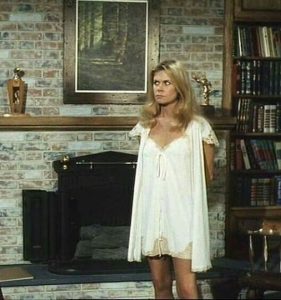Elizabeth Montgomery became a beloved household name and international icon during the 1960s, charming audiences with her natural beauty and undeniable talent. Her most famous role as the nose-twitching witch Samantha Stephens in Bewitched brought her into millions of homes across the country. Yet behind her enchanting screen presence was a deeply passionate and gifted actress whose life ended far too soon. Had she lived, the actress would have turned 91 in 2024. Instead, we look back on a career marked by brilliance, resilience, and unforgettable moments.

Born on April 15, 1933, in Los Angeles, Elizabeth Montgomery was destined for the spotlight. Her mother was a Broadway actress, and her father, Robert Montgomery, was a well-known film star. Acting was practically in her DNA. In a 1954 interview with the Los Angeles Times, Elizabeth recalled how, as a child, she would crawl into her father’s lap after dinner and confidently declare that she wanted to become an actress. Whether or not her father encouraged her dreams at the time, he certainly played a role in her early career. Elizabeth openly credited her father with helping her break into television, saying he was not only her greatest critic but also a loving father and trusted friend.
Elizabeth’s education began in California, but she eventually moved to New York City, where she attended the elite Spence School. Afterward, she studied for three years at the American Academy of Dramatic Arts. Her television debut came at a young age on her father’s program Robert Montgomery Presents, where she made several appearances that helped lay the foundation for her future success.
In 1953, she made her Broadway debut in Late Love, and by 1955, she had landed her first film role in The Court-Martial of Billy Mitchell. Her career steadily advanced, but her personal life faced its share of turbulence. Elizabeth married four times. Her first marriage to Frederick Gallatin Cammann in 1954 ended after just one year. She then married actor Gig Young in 1956, but they divorced in 1963.
While working on the film Johnny Cool, she met director and producer William Asher. They married that same year and went on to have three children together. Asher would play a key role in launching Bewitched, the show that would define Elizabeth’s legacy.
Although Elizabeth had notable roles in series like Alfred Hitchcock Presents, The Loretta Young Show, The Untouchables, and The Twilight Zone, nothing matched the success of Bewitched. Airing from 1964 to 1972, the show turned Elizabeth into a television superstar. With just a twitch of her nose, she captured hearts across America. The quirky charm of Samantha Stephens resonated with viewers, and Elizabeth’s ability to make magic seem effortless kept audiences coming back week after week.
Despite initial hesitation about committing to a television series, Elizabeth embraced the role. In a 1965 interview with the Associated Press, she admitted that the idea of playing one character for years concerned her, but she ultimately fell in love with the role. Her work on Bewitched earned her five Primetime Emmy nominations and four Golden Globe nominations, cementing her place as one of TV’s most beloved stars.
After Bewitched and her divorce from Asher, Elizabeth began a new chapter in her career. She took on roles in several made-for-TV movies, many of which contrasted sharply with the light-hearted tone of Bewitched. Her performances in films such as Mrs. Sundance (1973), A Case of Rape (1974), The Legend of Lizzie Borden (1975), Black Widow Murders (1993), The Corpse Had a Familiar Face (1994), and Deadline for Murder: From the Files of Edna Buchanan (1995) showed her dramatic range and helped her successfully transition into more serious roles.
During the filming of Mrs. Sundance, Elizabeth met actor Robert Foxworth. The two developed a lasting relationship, remaining together until her death. Though they waited decades to marry, finally tying the knot in 1993, their bond was strong and enduring.
Herbie J Pilato, author of two books about Elizabeth Montgomery, once remarked that before stars like Jane Seymour or Lindsay Wagner, Elizabeth was the true “Queen of the TV movie.” She had successfully reinvented herself after Bewitched, becoming a leading lady in a new genre and breaking away from the whimsical image of Samantha Stephens.
Tragically, Elizabeth’s life and career were cut short. On May 18, 1995, she passed away following a private battle with colon cancer. Although many sources list her birth year as 1933, her family told the Los Angeles Times she was 57 at the time of her death. She had thought she had beaten the disease, but while filming Deadline for Murder, she fell ill. When she finally sought medical attention in March 1995, it was too late—the cancer had already spread to her liver.
Elizabeth died peacefully in her sleep at her Beverly Hills home, surrounded by her husband and children. A memorial was held a month later at the Canon Theatre in Beverly Hills. The tribute included music by jazz legend Herbie Hancock and a heartfelt speech by author and longtime friend Dominick Dunne, who reminisced about their early days in New York City. Elizabeth’s ashes were scattered at the Westwood Village Memorial Park Cemetery in Los Angeles.
In a 1992 interview, Elizabeth reflected on her career, saying, “They all have different kinds of ‘feels’ to them, and that’s probably one of the reasons why I’ve done them. I get letters from people saying one of the things they like best about what I’ve done since Bewitched is that they never know what I’m going to do next.”
Looking at photos of Elizabeth Montgomery from her Bewitched days instantly brings back a sense of nostalgia and warmth. Her playful energy and signature nose twitch evoke memories of a time when television felt magical and full of charm. She wasn’t just an actress—she was a beacon of joy in American living rooms.
As Herbie J Pilato put it best, “Elizabeth was the least arrogant star I’ve ever met. She channeled that down-to-earthiness into Samantha, and we all loved her for it.” Her legacy continues to live on, reminding us of a time when television created true stars and when one actress could bring a little magic to the world simply by being herself.





